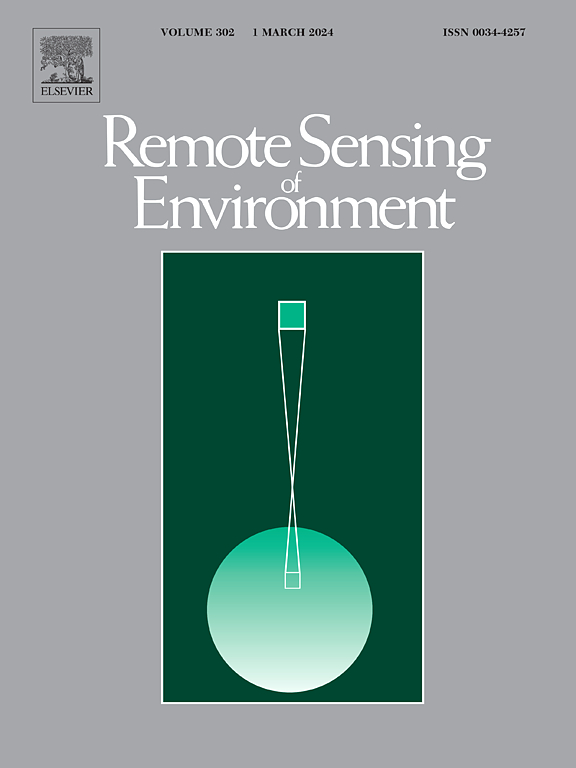利用Sentinel-2和SDGSAT-1热红外数据揭示纯碱盐碱区土壤盐分模式
IF 11.1
1区 地球科学
Q1 ENVIRONMENTAL SCIENCES
引用次数: 0
摘要
土壤盐碱化是全球土壤退化的一种重要形式,威胁着农业生产力和生态系统功能。准确测绘土壤盐度对可持续土地管理和知情决策至关重要。然而,传统的光学或雷达卫星传感器由于其热红外(TIR)覆盖范围不足,通常在探测关键的盐度光谱特征方面受到限制。TIR遥感在土壤盐分评估方面具有独特的优势,因为它对盐渍土壤在TIR光谱内的发射率非常敏感,但其应用仍有待探索。本研究评估了SDGSAT-1 TIS数据在世界三大碱土区之一的中国松嫩平原进行大尺度土壤盐度制图的适用性和鲁棒性。我们通过几种机器学习技术比较了整合SDGSAT-1 TIS数据的土壤盐度模型与使用光学(Sentinel-2)和雷达(Sentinel-1和GF-3)数据的土壤盐度模型的性能。我们的研究结果表明,结合SDGSAT-1 TIS数据显著提高了土壤盐度建模的准确性,始终优于仅基于Sentinel-2光学或Sentinel-1/GF-3雷达数据的模型。结合SDGSAT-1 TIS和Sentinel-2数据,利用高斯过程回归模型进行优化,获得最高的精度(R2 = 0.75, RMSE = 0.65 dS/m)。由此得出的盐度图揭示了该地区广泛的土壤盐碱化,大部分地区显示出轻微到中度的盐度水平,对植物生长和生态系统的恢复能力构成了重大挑战。该研究为TIR对土壤盐度的独特敏感性提供了可靠的数据驱动验证,强调了其整合到大规模土壤盐度制图框架中的潜力。本文章由计算机程序翻译,如有差异,请以英文原文为准。
Unveiling soil salinity patterns in soda saline-alkali regions using Sentinel-2 and SDGSAT-1 thermal infrared data
Soil salinization, a critical form of global soil degradation, threatens agricultural productivity and ecosystem functions. Accurate mapping of soil salinity is essential for sustainable land management and informed decision-making. However, conventional optical or radar satellite sensors are often limited in detecting key salinity spectral signatures due to their insufficient thermal infrared (TIR) coverage. TIR remote sensing offers unique advantages for soil salinity assessment, owing to its sensitivity to the emissivity of saline soils within the TIR spectrum, but its application remains underexplored. This study evaluated the suitability and robustness of SDGSAT-1 TIS data for large-scale soil salinity mapping in the Songnen Plain, China, one of the world's three largest soda saline-alkali soil regions. We compared the performance of soil salinity models integrating SDGSAT-1 TIS data with those using optical (Sentinel-2) and radar (Sentinel-1 and GF-3) data across several machine learning techniques. Our results demonstrated that incorporating SDGSAT-1 TIS data significantly enhanced soil salinity modeling accuracy, consistently outperforming models based solely on Sentinel-2 optical or Sentinel-1/GF-3 radar data. The combination of SDGSAT-1 TIS and Sentinel-2 data, optimized using the Gaussian Process Regression model, achieved the highest accuracy (R2 = 0.75, RMSE = 0.65 dS/m). The resulting salinity maps revealed widespread soil salinization across the region, with the majority of the area exhibiting slight to moderate salinity levels, posing substantial challenges to plant growth and ecosystem resilience. This study offers a robust, data-driven validation of TIR's unique sensitivity to soil salinity, emphasizing its potential for integration into large-scale soil salinity mapping frameworks.
求助全文
通过发布文献求助,成功后即可免费获取论文全文。
去求助
来源期刊

Remote Sensing of Environment
环境科学-成像科学与照相技术
CiteScore
25.10
自引率
8.90%
发文量
455
审稿时长
53 days
期刊介绍:
Remote Sensing of Environment (RSE) serves the Earth observation community by disseminating results on the theory, science, applications, and technology that contribute to advancing the field of remote sensing. With a thoroughly interdisciplinary approach, RSE encompasses terrestrial, oceanic, and atmospheric sensing.
The journal emphasizes biophysical and quantitative approaches to remote sensing at local to global scales, covering a diverse range of applications and techniques.
RSE serves as a vital platform for the exchange of knowledge and advancements in the dynamic field of remote sensing.
 求助内容:
求助内容: 应助结果提醒方式:
应助结果提醒方式:


